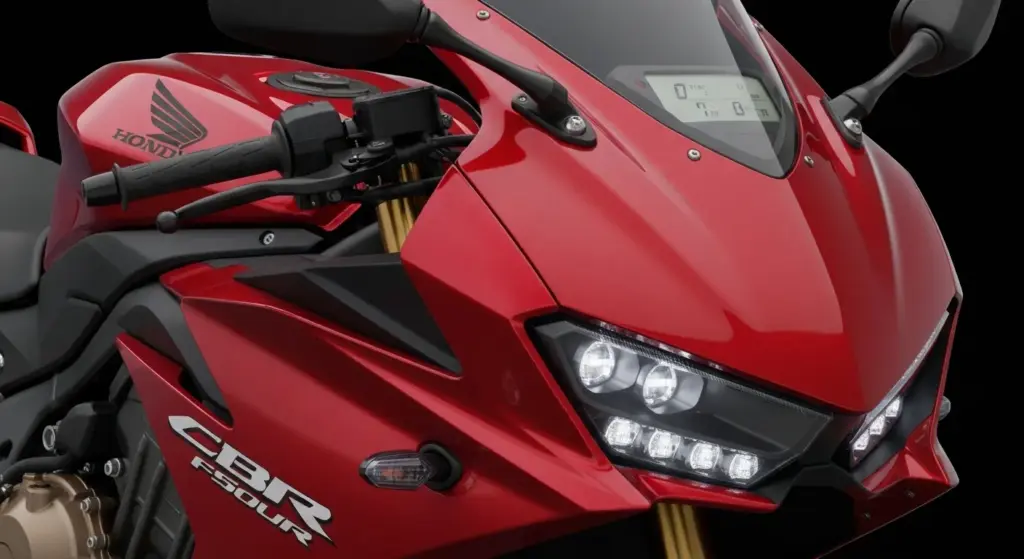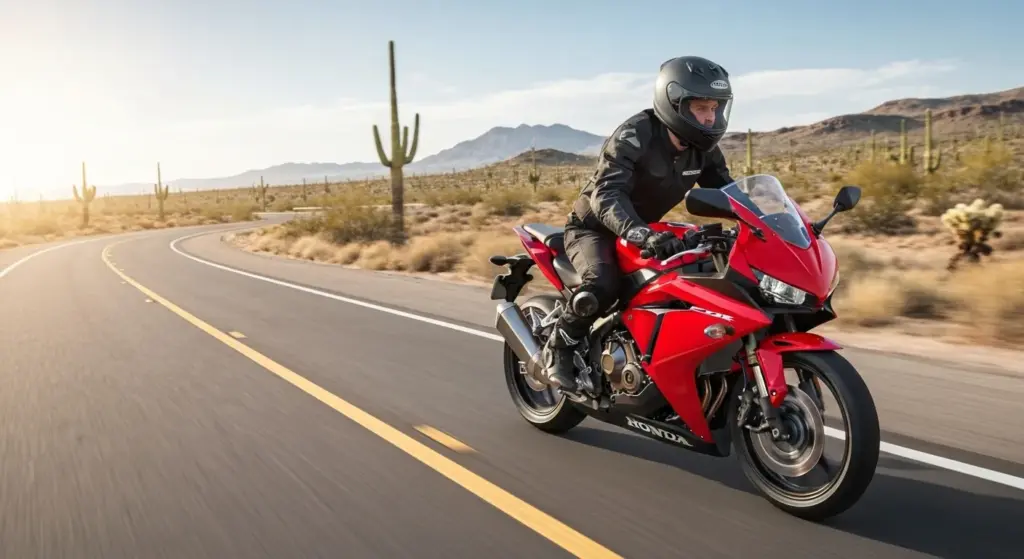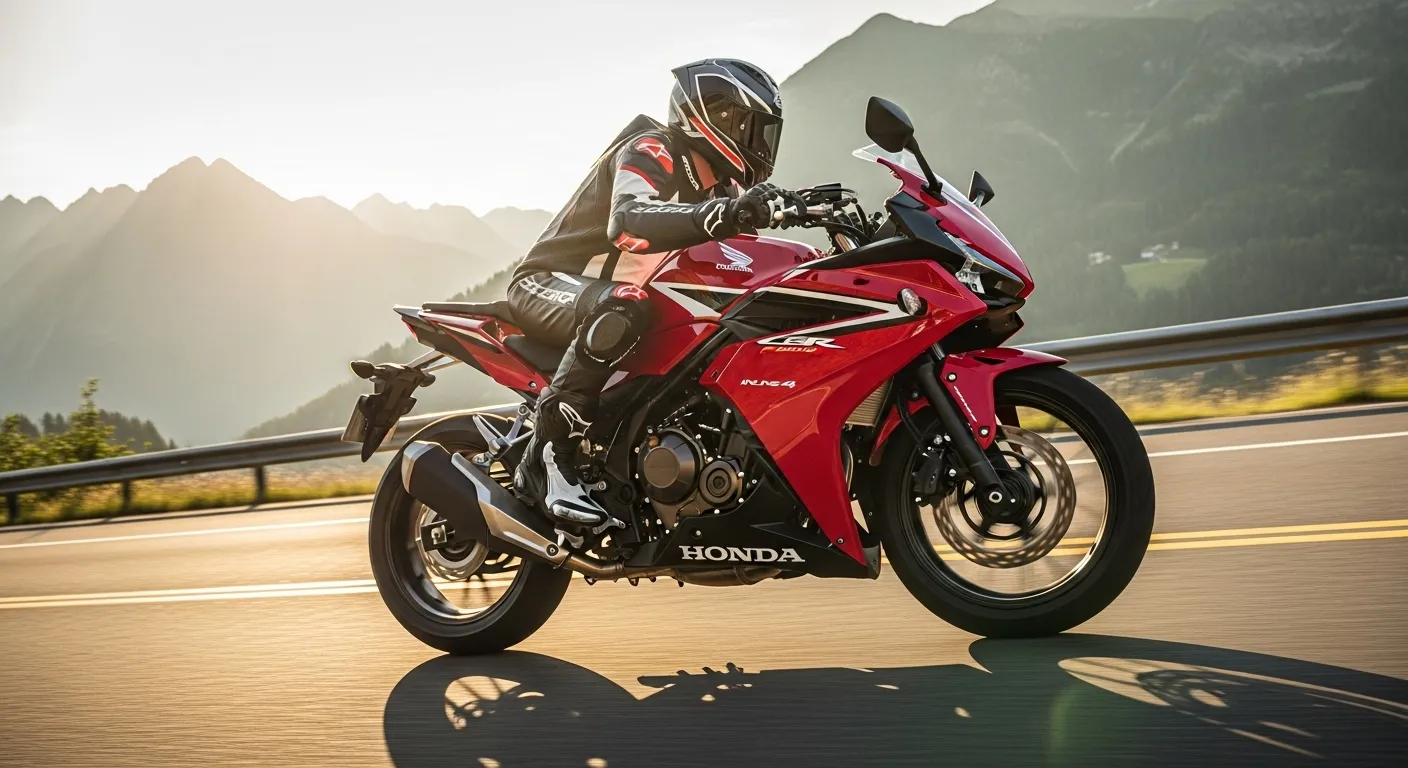As motorcyclists across the U.S. watch trends tilt toward higher performance even in mid-capacity bikes, Honda is making a bold statement. The unveiling of the 2026 Honda CBR500R Four means the brand is no longer content with incremental updates — it is rethinking what “middleweight” means. For American riders, this comes at an interesting moment: fuel prices remain volatile, demand for high-capability yet manageable machines is growing, and track days / canyon runs are seeing a resurgence among enthusiasts.
Honda’s decision to re-platform the CBR500R into an inline-4 configuration with advanced tech (such as the second-gen E-Clutch) signals that even entry-to-mid sport bikes are entering a tech arms race. Whether you’re commuting, canyon carving, or eyeing that first serious track day, the 2026 CBR500R Four could well be a turning point. The question now is: will it make the jump to U.S. shores, and with what pricing?
Fresh DNA: Engine, Frame & Powertrain Redefined

The most dramatic change in the 2026 CBR500R Four: a 502 cc inline-four, liquid-cooled engine, expected to deliver around 80 horsepower.
This is a departure from the outgoing twin, and positions the CBR500R Four to compete squarely against machines like the Kawasaki Ninja ZX-4R.
Honda has also integrated their second-generation E-Clutch system — small motors take over clutch control, enabling smoother shifts and automated downshifts, though manual override is still possible.
Of particular note: the E-Clutch unit has been relocated (from right to left side) to improve weight balance.
Beneath that, the CBR500R Four uses a diamond-shaped steel frame in which the engine acts as a stressed member.
Suspension comes as an upside-down (inverted) front fork and a rear monoshock with Honda’s ProLink linkage.
Braking setup: dual radial Nissin four-piston calipers up front, and a two-piston sliding caliper in the rear.
These changes point toward a sharper, sportier ride. The shift from twin to four means higher rev potential, more top-end thrust, and a smoother delivery — ideal for highway sprints and canyon blasts.
You must read this post : Harley’s Pan America S2 Rumor Heats Up After 2025 ST Launch
Spec Sheet & Real-World Impact
| Specification | Value / Estimate |
|---|---|
| Engine | 502 cc inline-4, liquid-cooled |
| Power | ≈ 80 HP (claimed) |
| Clutch | 2nd-gen E-Clutch with override |
| Frame | Diamond steel-frame, engine as stressed member |
| Front Suspension | Inverted fork (USD) |
| Rear Suspension | Monoshock + ProLink linkage |
| Brakes (Front) | Dual radial-mount Nissin, 4-piston |
| Brakes (Rear) | 2-piston sliding caliper |
| Weight | Not yet confirmed (target likely < 200 kg) |
| Markets / Launch | Unveiled in China; global rollout expected early 2026 |

Real-World Performance Notes:
While numbers remain provisional, the leap to ~80 HP should transform how the CBR500R feels on highway runs and spirited backroad rides — expect stronger pull above 7,000 rpm. The E-Clutch will help with urban stop-and-go, reducing rider fatigue, especially in traffic. The lighter, stiffer frame + inverted fork combo promises sharper feedback in corners. If weight stays under control, this bike could feel nimble yet planted.
However, real-world effectiveness will hinge on how Honda tunes the electronics, throttle response, and suspension — especially for U.S. road conditions (expansive straights, rough patches, extreme heat).
U.S. Prospects & Market Challenges
Despite the excitement, Honda hasn’t confirmed whether the CBR500R Four will come to the U.S. market. Many reports note that its unveiling happened in China (CIMAMotor 2025) and Honda’s launch timeline is still undefined for North America.
In U.S. terms, it would compete with the Kawasaki Ninja ZX-4R, Yamaha R7, or even the Triumph Street Triple / RS 660 in spirit (though those are naked / sport hybrids). The ZX-4R is likely the most direct adversary.
One hurdle: compliance with U.S. emissions and regulatory frameworks. Honda may need to adjust exhaust or electronics to meet EPA / CARB standards, which could slightly reduce power or add weight. Costs of homologation could push the U.S. price upward.
Still, if Honda brings the 2026 CBR500R Four stateside at a competitive price, it might re-energize the middleweight sport segment — especially for riders who want cutting-edge performance without jumping to liter bikes.
Reception, Hype & Community Buzz
Even before U.S. confirmation, the buzz is real. GearPatrol calls it “offensively dazzling” in design and tech. TopSpeed suggests the new inline-4 CBR looks like a “Ninja ZX-4R killer.”
In forums, prospective buyers express curiosity and caution. One user commented, “Knowing Honda, they won’t release the MY26 until all the MY25s are sold.”Some even plan to wait for this new version before pulling the trigger on a 2025 twin model.
Honda’s stealth approach — quietly unveiling in China and letting media do the speculation — has fueled speculation rather than official leaks. That mystique can help hype, but delays or missteps could backfire.
You must read this post : Moto Morini’s Calibro 700 Bagger Is America’s Next Affordable Touring Star
Who Should Watch, Wait, or Jump In?
If you’re in the U.S. and:
- You’re looking for a mid-capacity sportbike with modern tech, but don’t want to jump straight into liter class — this is a model to watch.
- You ride mostly highways and twisty backroads — the extra power and inline-4 character could feel like a step up.
- You commute in traffic — the E-Clutch is a strong plus for reducing fatigue.
- You’re budget conscious — wait until U.S. pricing and specs are confirmed; don’t preorder blind.
If Honda doesn’t bring the Four variant to U.S. shores (or delays it), the proven existing CBR500R twin model remains a reliable, well-loved option with aftermarket support and easier compliance with domestic rules. (See Honda’s official spec page for the current CBR500R twin design)
Final Thoughts
The arrival of the 2026 Honda CBR500R Four marks a turning point: Honda is pushing beyond evolutionary tweaks and into architectural reinvention. With a 502cc inline-4, enhanced E-Clutch, stiffer frame, and aggressive styling, it’s set to rise above traditional middleweights — if it comes to the U.S. in true form.
Its strengths could be in its torque curve, usability in traffic, and presence among sportbike peers. Its risks: cost, regulatory adaptation, and whether the incremental weight gains or ECU tuning will dampen the promise.
For now, U.S. riders should keep a close eye. If Honda confirms a domestic launch, this could become one of the most compelling mid-capacity sportbike offers in years — ideal for someone who wants more bite than a twin but without the extremes of a liter-class machine.

